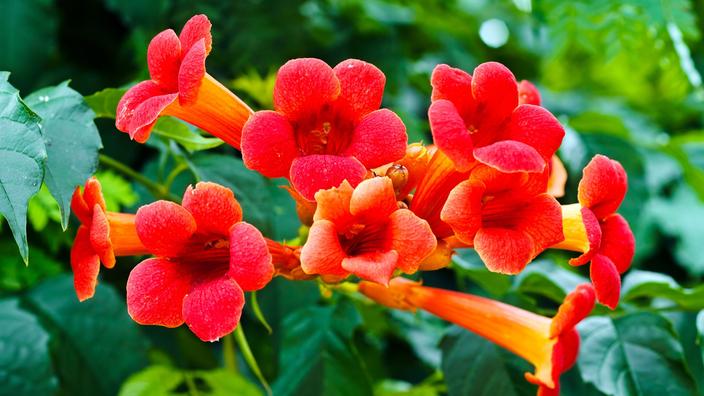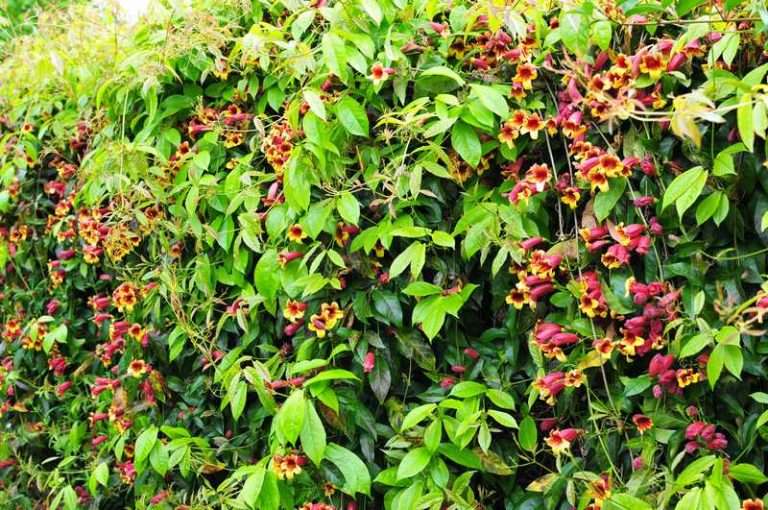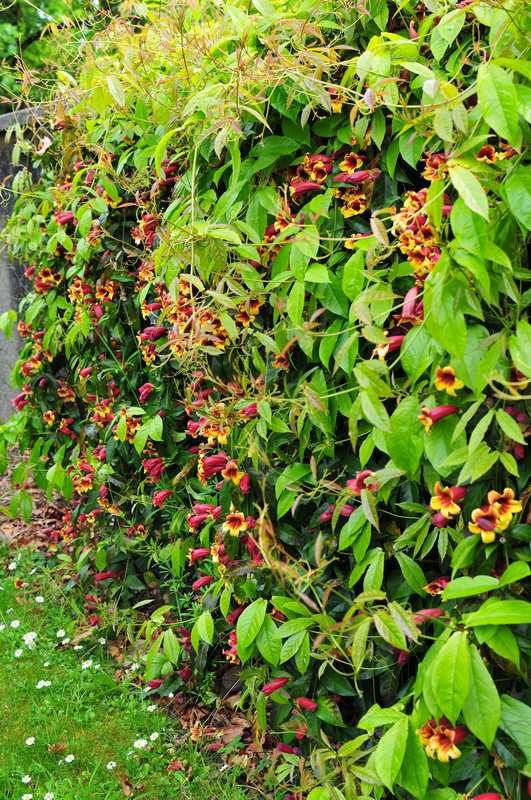
Native to the southeastern United States, Bignonia capreolata is a beautiful, evergreen vine in the bignone family (Bignoniaceae) . Particularly elegant when it is trellised on a wall or on a sunny facade, it is covered in spring with flowers with the delicious scent of roasted coffee and chocolate.
What there is to know :
Name: Persistent bignone, chocolate bignone, coffee bignone, tendril bignone.
Botanical name: Bignonia capreolata, Campsis capreolata
Origin: USA
Family: Bignoniaceae
Height and spreading: Depending on the growing conditions, this climbing plant reaches 3 to 10 m in height and about 3 m in width. Its growth is rapid.
Foliage: Persistent. The elongated, dark green, glossy leaves persist in areas with mild winters, but may partially drop in colder regions.
Flowering: The evergreen bignone produces between April and June flowers in yellow trumpets with dark red throats. They are lightly scented and give off a smell of chocolate and roasted mocha coffee which is at the origin of the nicknames bignone chocolat or bignone café given to this beautiful evergreen climbing plant.
Exposure: In the sun, facing south , the evergreen bignone needs a lot of light and heat to flower well.
Soil: Rich, deep and well-drained soil, but which remains ideally cool in summer. It tolerates drought well.
Hardy: The strain resists down to -10°C or -12°C but the branches freeze before, at around -8°C.

Where to plant Bignonia capreolata in the garden?
This evergreen bignone is particularly exuberant when it is trellised against a facade or a warm and sunny wall: Expose it to the West or to the South in the cooler zones.
You can also plant it at the foot of a chain-link fence , a trellis, an arch, the trunk of a dead tree, which it will soon attack, or even at the foot of a pergola that you want to shade while enjoying the pleasant scent of its flowers.
Bignonia capreolata clings to its support on its own by means of its suction cups.
Planting tips for Bignonia capreolata
To bloom well, this climbing plant needs a warm, sunny location, sheltered from cold winds. But it also likes to keep the roots cool in summer, for example in the shade of perennials, a shrub or a low wall.
Plant the tendril bignone in the spring , in April or May, when there is no longer any risk of frost.
- Dig a hole 25 cm deep.
- Loosen the bottom.
- Meanwhile, soak the root of your chocolate bignone in a bucket of water to moisten it well.
- Then remove the container, then put the plant in its hole, keeping the top 5 cm below ground level and resting the stake on the trellising support.
- Fill with soil, covering the clod.
- Tamp firmly with your hands, then water copiously.

Maintenance and cultivation of Bignonia capreolata
Easy to grow, the chocolate bignone requires little maintenance .
Protection of the Bignone with tendrils in winter
If this climbing plant is hardy, it appreciates some protection measures against the cold in winter.
When negative temperatures are expected , cover all the aerial parts under a wintering veil.
In very cold weather , the leaves of the evergreen bignone take on a purple color and sometimes partially drop. But they push back vigorously in the spring as soon as the thaw begins.
Also protect the stump against the cold by spreading a thick mulch of shredded branches and dead leaves at the foot of your plant in the fall.
watering
Once installed , Bignonia capreolata withstands drought well; so it is not useful to water it. In the first year, on the other hand, regular water supply is required in order to obtain quality rooting.
Fertilizer
Bignonia capreolata blooms best in rich soil. Bring mature compost to the foot of this climbing plant at least twice a year, in spring and at the beginning of autumn, so that it produces a greater quantity of flowers.

How to prune the persistent ridge?
During the summer, after the end of flowering, roughly prune your bignone capreolata with shears to remove all the faded flowers and balance its silhouette.
Complete this pruning with an intervention at the end of winter, in February or March depending on the mildness of your climate, which aims to remove dead wood and twigs damaged by frost .
How to make a cutting of Bignonia capreolata?
Cut your chocolate bignone in July from the ends of young shoots about 10 cm long. Stew them. Optimum rooting is achieved the following spring.
The layering of its long stems also gives many plants to be taken and replanted elsewhere after only a few months. All you have to do is cover them with soil when they touch the ground.
